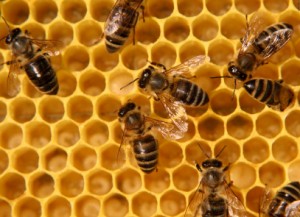Welcome! The main component of beekeeping hinges on the hive in which the bees deposit honey. By improving the hives for the bees to work with, harvesting of honey has become more efficient over the years.
While the langstroth hive is most commonly used in United States. It is what is called a movable frame beehive. The support structure of the Langstroth hive is a rectangular wooden frame which holds the combs within it. Within the frame it is not surprising to find nine or ten of these combs. Amazingly, there is no top or bottom of the frame as the combs hang freely within. The combs are made of a sheet of wax or plastic foundation. Bees produce wax to build honeycombs by using wax sheets as starting points. They are then able to deposit honey and pollen in to the cells of the comb. The box is designed to basically be able to remove the frames filled with honey to be extracted.
In Africa there are Top-bar hives that beekeepers in United States are using. A Top-bar hive has bars across the top of the structure which allows the honey bees to attach and hang wax combs from. Different from the frames that are used in a Langstroth hive, the combs on bars cannot be reused after the honey extraction. This type of design leads to a lower production of honey. But the honey from the clear yellow combs produced in a top-bar hive is of the highest quality. It is also sold as in-comb honey product.
Irregardless of the design, important aspects like space of building hives needs to be considered. First off, before the beekeeper decides to keep bees on their property they must research the local restrictions to keeping bees present in some areas. They ought to also think about the amount of room that is available on their property and the location of the hive. Bee hives should not be placed close to residential areas or place for recreation. Bees can be bothersome to some people those who suffer from bee sting allergies. The bee hives also needs to be placed near nectar and pollen sources in order to give the bees simple access to a food source.
While some beekeepers use bees solely to pollinate their crops. The hive ought to even be placed near a fresh-water source. This can be a natural water source or something that is supplied by the beekeeper. Another important aspect that ought to be considered about when placing a bee hive on one’s property are predators and vandals. The hive needs to be shielded from natural predators like bears and skunks and from human vandals that might have an interest in gathering some free honey. The hive must also be protected from extreme weather conditions as it is optimum to be available throughout the year. Although bees are most active in the coursework of positive times of the year, beekeeping is a job that lasts throughout every season of the year.
So why wait and get started now my friend!
Article Source: http://www.articlesbase.com/pets-articles/beekeeping-understanding-the-bee-hive-3124384.html
About the Author
Visit http://www.honeybeesbeekeeping.com for more information on beekeeping hive.


